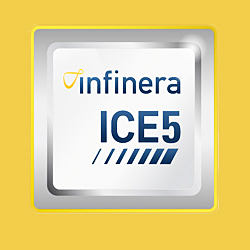15 Mar 2018
A selection of new launches and demonstrations from this week’s event in San Diego.
For more than 40 years, the OSA’s Optical Fiber Communication Conference and Exhibition has drawn visitors from all corners of the globe to discover the latest in high-tech communications technologies. OFC covers the entire supply chain and provides a marketplace for new products ranging from optical components and devices to systems, test equipment, software and specialty fiber. Here optics.org reviews a sample from this week’s event.Nokia says it is “pushing optical network capacity to theoretical limits” with its Photonic Service Engine 3 chipset; enabling “massive scale and radical simplicity for video, cloud and 5G growth”. It is said to be the first chipset to implement probabilistic constellation shaping (PCS), a technique pioneered by Nokia Bell Labs that pushes fiber-optic performance close to the “Shannon limit”.
The chipset enables maximum capacity over any distance and on any fiber – from metro to subsea – increasing capacity up to 65% over currently deployed networks while reducing power by 60%; it also reduces complexity and dramatically simplifies network operations.
Nokia has announced the next generation of its Photonic Service Engine range of super-coherent digital signal processors, underscoring its leading position in the industry and innovation pedigree. Nokia says the PSE-3 “will be instrumental in the evolution of communication service provider and webscale networks to meet the surging traffic demands of video, cloud and 5G by maximizing the capacity and performance of every link in their optical networks.”NeoPhotonics, a developer of hybrid photonic integrated circuit based modules and subsystems for bandwidth-intensive, high speed communications networks, has announced its 53 Gbaud linear optical component family, which includes PAM4-capable optical components for 100G and 400G cloud data centre and other client applications, including drivers and EML lasers in transmitters plus PIN photodetectors and TIAs in receivers.
Cloud data centres are generating strong demand for transceiver solutions with higher port densities and lower cost per bit, which is driving the technology shift to single-lambda 100Gbps with PAM4 technology.
The NeoPhotonics 53 Gbaud range offers module designers a complete set of optical components with accompanying analog electronic chips designed to achieve high performance with low power consumption in small form factor applications.InnoLight Technology, a developer of data center optics, announced the availability of what it calls "the industry's first 400G QSFP-DD FR4 optical transceiver" at OFC 2018. the company also introduced several new elements to its range of 400G OSFP and QSFP-DD optical transceivers.
With the insatiable demand for higher bandwidth of hyper-scale data centers, 400G optical transceivers are urgently needed to lower bandwidth cost. OSFP and QSFP-DD are the desired 400G solutions for next generation cloud networks. To support this rapid growth, InnoLight has introduced a range of 400G QSFP-DD and OSFP optics systems.
Osa Mok, Chief Marketing Officer of InnoLight, commented, "Both OSFP and QSFP-DD have been adopted as the next generation 400G optics for cloud networks. Each solution has its advantages and target applications. Depending upon the cloud operator's network architecture, either QSFP-DD or OSFP offers the most cost effective solutions for 400G data center network connectivity.
“InnoLight, with our advanced R&D capability and strong technology partnerships, is proud to bring both form factors to the market simultaneously. 400G QSFP-DD excels in backward compatibility with 100G/200G QSFP28/56. 400G OSFP stands out in enabling upward migration to 800G. InnoLight is aggressively driving adoption of both 400G form factors to deliver the best price performance optics in the industry," Mok added.Oclaro – newly acquired by Lumentum – has announced production shipments of what it calls “the industry's first fully-tunable SFP+ industrial temperature range (TSFP+ I-temp) transceiver”. This transceiver is deigned for cable companies deploying the latest DOCSIS 3.1 standard, which pushes fiber installation much deeper into the HFC network to reach next-generation "Remote Phy nodes".
Yves LeMaitre, Chief Strategy Officer at Oclaro, commented, "Cable networks need to offer best-in-class bandwidth to retain their customers and enable premium services. With more than 50 million homes served by MSOs in the US alone and up to 1 million new nodes, the deployment of 10G full-duplex per node over the next four to five years can only be achieved with products such as fully-tunable DWDM lasers that are easy to install, configure, and monitor."
He added, "Fully Tunable DWDM laser technology is critical to enable large scale fiber deep deployment while minimizing operations cost and eliminating human errors. With tunable lasers capable of operating from -40 to 85 degrees C, we believe the days of analog optics or fixed WDM lasers are counted. Once you start using tunable products, the operational benefits such as automatic configuration and reduced sparing are just too great to go back to legacy optics."
Infinera, a developer of Intelligent Transport Networks, unveiled ICE5, the industry’s first 2.4 terabits per second optical engine and the latest addition to the company’s family of Infinite Capacity Engines. ICE5 is targeted at internet content providers scaling connections between data centers and communications service providers planning fiber-deep architectures including distributed access architecture and 5G mobile backhaul.

Infinera.
At OFC 2018, Luxtera announced multiple optics products and gave various technology demonstrations of its latest optics innovations, intended to meet growing demand for Cloud, hyperscale, enterprise data centers, and the evolving 5G mobile Infrastructure networks.
The company showcased its latest advancements in 100G-plus technology, PAM4 signaling, extended reach, increased operating temperature range, liquid immersion cooling, increased density and photonic integration. Demonstrations included:
| © 2025 SPIE Europe |
|